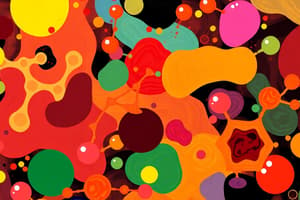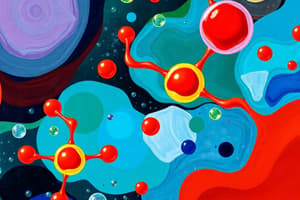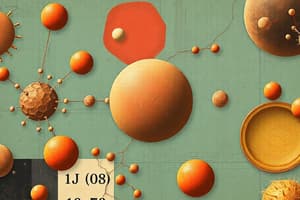Podcast
Questions and Answers
Which of the following is NOT a characteristic of lipids?
Which of the following is NOT a characteristic of lipids?
- Important for biological functions
- Low solubility in water
- Polymers (correct)
- Include fats, phospholipids, and steroids
What is the structural unit of steroids, consisting of 17 carbon atoms?
What is the structural unit of steroids, consisting of 17 carbon atoms?
- Steroid chain
- Steroid nucleus (correct)
- Steroid ring
- Steroid backbone
Which of the following is NOT a function of cortisol?
Which of the following is NOT a function of cortisol?
- Control of blood pressure (correct)
- Control of protein metabolism
- Control of carbohydrate metabolism
- Control of lipid metabolism
What is the primary female sex steroid hormone?
What is the primary female sex steroid hormone?
What is the primary component of beeswax?
What is the primary component of beeswax?
Flashcards
Lipids
Lipids
Biomolecules defined by low water solubility; includes fats, phospholipids, and steroids.
Fat Cells
Fat Cells
Human body contains 10-30 billion fat cells that remain throughout life, shrinking when losing weight.
Steroid Structure
Steroid Structure
Steroids have a four fused carbon ring structure, known as steroid nucleus, with 17 carbon atoms.
Cholesterol
Cholesterol
Signup and view all the flashcards
Waxes
Waxes
Signup and view all the flashcards
Study Notes
Lipids
- Defined by low solubility in water
- Not polymers
- Major biological components: fats, phospholipids, and steroids
Types of Lipids
- Fatty Acids: Vary in length and number/location of double bonds
- Short-chain (2-4 carbons)
- Medium-chain (6-10 carbons)
- Long-chain (12 or more carbons)
- Saturated (no double bonds)
- Unsaturated (one or more double bonds)
- Triglycerides: Composed of glycerol and three fatty acids
- Sn1, Sn2, Sn3 positions
- Phosphoglycerides: Glycerol backbone with two fatty acids and a phosphate group
- Hydrophilic head (polar)
- Hydrophobic tail (non-polar)
- Waxes: Long-chain alcohols esterified to long-chain fatty acids
- Steroids: Four fused carbon rings (steroid nucleus)
- Cholesterol (membrane sterol)
- Cortisol (adrenal hormone)
- Progesterone (hormone precursor)
- Testosterone (male hormone)
- Estradiol (female hormone)
- Sphingolipids: Sphingosine or 4-sphingonine backbone
- Sphingomyelin (myelin sheath components)
- Cerebrosides (brain & nervous tissue, glucose/galactose sugar)
- Sulfatides (brain and nervous tissue, sulfate-esterified galactose sugar)
- Gangliosides (three or more sugars, including sialic acid)
Hydrogenated Fats
- Polyunsaturated vegetable oils with added hydrogen, leading to solid form at room temperature
- Process called hydrogenation converts polyunsaturated oils to saturated fats
- Margarine and shortening are examples
Trans-Fatty Acids (TFAs)
- Produced when hydrogen is added to monounsaturated or polyunsaturated fats
- Raise low-density lipoproteins (LDL) and total cholesterol
- Found in baked goods and processed foods
Lipid Transport
- Lipoproteins transport lipids in the blood
- Chylomicrons: largest and least dense, transport diet-derived lipids from intestines
- VLDL: made by liver, transport lipids to tissues
- LDL: composed primarily of cholesterol, transport lipids to tissues
- HDL: composed primarily of protein, removes cholesterol from cells to liver
Number of Fat Cells
- Average human body has between 10 and 30 billion fat cells
Studying That Suits You
Use AI to generate personalized quizzes and flashcards to suit your learning preferences.




